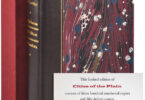Jane Austen is an English novelist who is best known for penning the popular novels Pride and Prejudice and Sense and Sensibility.
Her works of romantic fiction were relatively groundbreaking for the Regency Era. These realistic tales were set among the landed gentry, and are considered historically important due to her sharp commentary on social matters.

Austen was born on December 16, 1775, and was well educated as were many young ladies of the gentle class. Jane and her sister Cassandra spent some time away from home for their education but became ill with typhus and returned home, thus sparing their family the expense of their boarding school education. The remainder of their education was provided by interaction and discussion with their father and older brothers, as well as on their own, browsing their home library.
Jane was allowed to read as often as she wished and encouraged to write, even from a young age. Jane and Cassandra were given complete access to the family’s reading and writing materials, and their father encouraged intellectual debate and allowed his daughters to engage in some rather risqué writing experiments. Under these conditions, Jane was able to create poems, stories, and plays, now compiled as a collection called Juvenilia. Among these works is The History of England, a 34-page satirical manuscript by Jane with 13 watercolor miniatures by Cassandra.
Around the age of 14, Jane Austen decided to “write for profit, to make stories her central effort.” This marks the beginning of her effort to write longer works, and so Lady Susan was created. This short novel was ambitious and quite edgy for the time, as the main character is a woman who uses her charm to manipulate and abuse her loved ones.
Her next novel was called Elinor and Marianne, but this story told through letters was later revised and published as Sense and Sensibility in 1811. Austen also began work on a second novel around 1796, called First Impressions. This novel later became Pride and Prejudice and was her family’s favorite as she read aloud to them all of her creations. In 1798, she finished a series of revisions on Elinor and Marianne and began her third novel, a satire, with the working title Susan, which later was called Northanger Abbey.
In 1804, Jane’s father passed away, leaving Jane, Cassandra, and their mother in a difficult situation, but the brothers of the family offered their assistance in maintaining their sisters and mother. This tenuous financial status caused the Austen ladies to live an unsettled life; being forced to move between the brothers’ homes and occasionally renting rooms as often as possible. The money problems seem to have made Jane focus on achieving publication, and with the help of her brother Henry, she managed to find a publisher to print Sense and Sensibility in 1811. The book was attributed to “A Lady” and was well received by the public. The first edition sold out by 1813, and the publisher, Egerton released Pride and Prejudice in the same year. Egerton had to run a second edition within 10 months to keep up with demand. The public raved about her next book, Mansfield Park, in 1814, but the critics did not enjoy this departure from her previous tales.
There are few people whom I really love, and still fewer of whom I think well. The more I see of the world, the more am I dissatisfied with it; and every day confirms my belief of the inconsistency of all human characters, and of the little dependence that can be placed on the appearance of merit or sense.”
— Jane Austen (Pride and Prejudice)
Jane Austen was achieving some financial solvency by this time, but it was not quite enough money or renown to keep herself and her sisters afloat. She found a more wide-reaching publisher from London, and he published Emma in December 1815 and the second edition of Mansfield Park in February 1816. These two books did not generate the same success as did her previous publisher and Austen just barely broke even on this venture.
Around this time, her brother’s bank collapsed and cost much of the family large sums of money. The brothers were no longer able to maintain Jane, Cassandra, and their mother after this financial disaster.
By the beginning of 1816, Jane’s health went into decline. She attempted to bully through her illness, working on a new novel called The Elliots (later Persuasion), but by summer, the decline in her physical condition was evident to all around her. Nevertheless, she began work on yet another novel called The Brothers (later Sanditon) but had to stop by March 1817 due to her illness. By mid-April, Austen was bedridden, and finally succumbed to her ill health and passed away on July 18, 1817.
After their sister’s death, Cassandra and Henry Austen arranged the publication of Persuasion and Northanger Abbey in December 1817, adding a biographical note which identified his sister as the author of the novels and offered a eulogy to their beloved story-teller. The popularity of her novels declined after her death and were out of print until 1832. Since 1833, Austen’s novels have been continuously in print, and in high demand.
Want to know more about Jane Austen?
Shop the works of Jane Austen or visit her author profile page to read more about this remarkable author.






